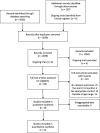Deworming in non-pregnant adolescent girls and adult women: a systematic review and meta-analysis
- PMID: 30572948
- PMCID: PMC6300900
- DOI: 10.1186/s13643-018-0859-6
Deworming in non-pregnant adolescent girls and adult women: a systematic review and meta-analysis
Abstract
Background: The impact of deworming on parasite load, nutritional status and other health outcomes of non-pregnant adolescent girls and adult women is uncertain.
Methods: MEDLINE, EMBASE, CINAHL, the Cochrane Central Register of Controlled Trials, the WHO International Clinical Trials Registry Platform, the Cochrane Database of Systematic Reviews and Food and Technology Abstracts databases were searched until 24 September 2018. Studies were included if they were randomised controlled trials (RCTs), controlled before and after studies or interrupted time studies comparing deworming with no intervention or placebo in non-pregnant adolescent girls and women 10 to 49 years old. Outcomes of interest included parasite load, reinfection, anaemia, severe anaemia, iron deficiency, diarrhoea or all-cause morbidity. Risk of bias was assessed using the Cochrane risk of bias tool.
Results: We included four RCTs of mass deworming involving 1086 participants, in the analyses. Mass deworming probably reduces the prevalence of roundworm infection (RR 0.29; 95% CI 0.14 to 0.62; 2 trials; 1498 participants, moderate certainty evidence), prevalence of hookworm infection (RR 0.32; 95% CI 0.18 to 0.59; 2 trials; 1498 participants, moderate certainty evidence), prevalence of whipworm infection (RR 0.77; 95% CI 0.65 to 0.91; 2 trials; 1498 participants, moderate certainty evidence) compared to the control group. Deworming may make little or no difference in prevalence of anaemia (RR 0.82; 95% CI 0.60 to 1.11, 3 studies, 683 participants, low certainty evidence) and prevalence of iron-deficiency (RR 0.89; 95% CI 0.64 to 1.23, 1 study, 186 participants, low certainty evidence) compared to control. We are uncertain whether deworming reduces the prevalence of severe anaemia compared to control as the certainty of evidence was very low. None of the included studies assessed screen and treat deworming or reported reinfection, diarrhoea or adverse events.
Conclusions: Mass deworming probably reduces the prevalence of soil-transmitted helminth infections but may have little or no effect on anaemia and iron-deficiency in adolescent girls and non-pregnant women in comparison to no intervention or placebo. We are uncertain about the effect on severe anaemia. These results are limited by sparse data and the moderate to very low quality of evidence available.
Systematic review registration: The protocol was registered in PROSPERO (registration number: CRD42016039557 ). Primary source of funding: Evidence and Programme Guidance unit, Department of Nutrition for Health and Development, World Health Organization (WHO).
Keywords: Anaemia; Deworming; Haemoglobin; Non-pregnant; Soil-transmitted helminthiasis; Women.
Conflict of interest statement
Ethics approval and consent to participate
Not applicable.
Consent for publication
Not applicable.
Competing interests
VW, ETG and AH are authors on a Campbell systematic review and network meta-analysis on deworming in children.
PR and JPP are full-staff members of the World Health Organization (WHO). The authors alone are responsible for the views expressed in this article and they do not necessarily represent the views, decisions or policies of the World Health Organization.
SS has no competing interests to declare.
Publisher’s Note
Springer Nature remains neutral with regard to jurisdictional claims in published maps and institutional affiliations.
Figures









References
-
- World Health Organization . Soil-transmitted helminth infections: fact sheets. 2015.
-
- de Silva N, Guyatt H, Bundy D. Morbidity and mortality due to Ascaris-induced intestinal obstruction. Trans R Soc Trop Med Hyg. 1997;91(1):31–36. - PubMed
-
- Albonico M, Stoltzfus R, Savioli L, Tielsch J, Chwaya H, Ercole E, et al. Epidemiological evidence for a differential effect of hookworm species, Ancylostoma duodenale or Necator americanus, on iron status of children. Int J Epidemiol. 1998;27(3):530–537. - PubMed
-
- Dreyfuss ML, Stoltzfus RJ, Shrestha JB, Pradhan EK, LeClerq SC, Khatry SK, et al. Hookworms, malaria and vitamin A deficiency contribute to anemia and iron deficiency among pregnant women in the plains of Nepal. J Nutr. 2000;130(10):2527–2536. - PubMed
Publication types
MeSH terms
Substances
Supplementary concepts
Grants and funding
LinkOut - more resources
Full Text Sources
Molecular Biology Databases

